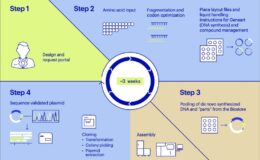
Wherever you go, you leave behind a little bit of yourself. Hair, skin flakes, your saliva on a coffee cup or cigarette. How much information do these traces hold? What if it was possible to recreate your likeness based on the DNA you leave behind?
Artist Heather Dewey-Hagborg has been exploring these ideas through her piece Stranger Visions. In 2012, she collected chewing gum, cigarette butts and other discarded items from public places in New York City, and used these create a series of 3D portraits based on the DNA from these found objects.

One of the Stranger Visions portraits, created by Heather Dewey-Hagborg from DNA found in public places.
Heather Dewey-Hagborg
“I was very lucky that the world’s first community biology lab had just opened up down the street from me in Brooklyn,” says Dewey-Hagborg. “It’s called Genspace, and I took a crash course there with Ellen Jorgensen and learned the basics [of DNA analysis].”
With help from Genspace, she learned how to isolate DNA from the items she picked up, and amplify certain parts of it using the same type of polymerase chain reaction (PCR) process that forensic scientists use to find a match between a suspect and crime scene evidence. In that situation, they would focus on regions of DNA that are usually different between people, and compare them to see if they’re the same.
But creating a likeness of someone’s face based on segments of found DNA is not nearly as straightforward. Dewey-Hagborg used PCR to amplify certain regions of the DNA that are associated with visible traits, such as eye color or nose size, for example. She would send these samples to a lab to read the DNA sequence – the order of As, Cs, Gs and Ts that make up the genetic code – and then look up which trait was associated with that particular genetic variant.
“I started making this very basic list of these kinds of associations with what are called SNPs, single nucleotide polymorphisms, drawing on resources like 23andMe and a site called SNPedia, which is like Wikipedia for SNPs.”
From there, Dewey-Hagborg used a mathematical model of the face that she could edit using software to represent the facial characteristics suggested by the DNA sample. That then formed the basis for the 3-D printed, life-sized model of the face.
When Dewey-Hagborg first created Stranger Visions, this technology was purely speculative, and a commentary on the role of surveillance in society. But not long after, a company called Parabon NanoLabs began offering similar technology as a forensic service, to create reconstructed mugshots from a DNA sample.
“That was the impetus for me to shift my discourse,” says Dewey-Hagborg. “[I moved] from talking about surveillance and the risks of this new technology to writing and speaking about the limitations of tools like that.”
It’s very difficult to predict what someone looks like based on their DNA. Genetic variants show very strong links with particular traits, but it’s not an exact science. There are different possible facial interpretations for each genetic variant. That was a challenge in the process of creating the Stranger Visions portraits, too.
“For each sample, what I ended up doing was generating five or six different versions. And then I would choose one that felt interesting to me or that I felt some connection to.”
The reason it’s so unpredictable is that there are many different genes that can interact with other and regulation of gene expression is a complex process that relies on a lot more than just the sequence of letters in the DNA.
Another of Dewey-Hagborg’s pieces, Probably Chelsea, further brings home how unpredictable this technology is. Here, the DNA donor was not an anonymous gum chewer, but Chelsea Manning. From Manning’s DNA, Dewey-Hagborg created a series of several possible faces. Many of them look nothing like the whistleblower, but a few bear a passing resemblance if you know it’s her.
The unpredictable nature of the method also means that the people who left behind their genetic material on the objects that Dewey-Hagborg picked up from the streets of New York, may not even have recognized themselves if they ever saw Stranger Visions.
Now, one of these portraits is on display at the new exhibit “Being Human”, at the Wellcome Collection in London.
With an estimate of close to half a million CCTV cameras in the city, keeping an eye on people as they go about their day, London is one of the most monitored cities in the world. As a commentary on surveillance, this Stranger Visions portrait might therefore have a different impact on a London audience than it has for the people in other places the work has been displayed.
But at the Wellcome Collection, this piece is part of an exhibit that encourages people to think about identity, and that’s very much in line with Dewey-Hagborg’s vision as well.
“My hope is that people will walk up to the face and think ‘that could be me, that could be my DNA’, and reflect on what that means socially or politically.”
One of the portraits from Stranger Visions is on display from September 5th, at the new permanent exhibit “Being Human”, at the Wellcome Collection in London.














